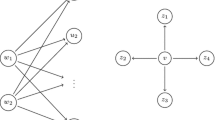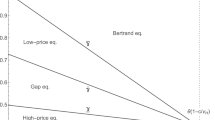Abstract
This paper considers a quality signaling game in which consumers share information on quality with their neighbors in a social network. The firm chooses a set of consumers to whom to offer their product and a price across two stages of sales. When this publicly-observable localization is available, the cheapest way for the high quality seller to separate herself from a low quality seller is to initially offer the product to the smallest set of consumers who will saturate the network with word-of-mouth; targeting a set that generates less word-of-mouth will require more money-burning to successfully signal. The set is idiosyncratic and identifying it requires considering the connectivity of sets of nodes in the network collectively, rather than relying on individual measures of connectivity. Observable networks therefore enable credible signaling that is less socially wasteful than would otherwise be the case, and this benefit is greater the smaller is the set of consumers which will cover the network with word-of-mouth.




Similar content being viewed by others
Notes
This is the lowest-cardinality set such that all nodes in the graph are either in the set or one degree away from a node in the set.
This price discount is equivalent to any “money-burning” signaling action, such as non-informative advertising expenditure.
While we focus on the application of a social network, depending on the setting we could also apply the model to any type of network structure that admits localized strategies, for example geographic, professional or collaboration networks.
That the graph is connected is without loss of generality, since an unconnected graph would in this model be qualitatively identical to each of its connected components.
This is consistent with the good being a durable or an experiential product, and rules out the well-understood signaling mechanism of repeat purchase in order to isolate the effect of communication among consumers.
The technical burden borne by this assumption also differs in how we interpret ‘consumers’ in the model. For example, we could view ‘consumers’ as audiences of distinct websites, and the links between them as hyperlinks or cross-posts.
The price discount required is strictly more costly unless some consumer in the minimum dominating set has only a single neighbor outside the set.
Note that although the firms are ‘separated’ by word-of-mouth and experience different round 2 outcomes, in equilibria of this class the two types of firm may choose identical strategies in round 2, since the low type firm will be indifferent between mimicking the high type strategy (thus making no sales) and setting some different strategy.
We may also note that if we maintain q L < 0, so that a low quality product has negative value to a consumer, the analog of the S1 equilibrium with a network unobservable to consumers would involve a negative price sufficient to make purchase weakly acceptable to each targeted consumer, although naturally the payoff to the high type would be lower. This strategy would be equivalent to a firm paying consumers to ‘test’ a new product.
A caveat to this point is that it will apply only to the population of ‘sophisticated’ consumers. Brown et al. (2012) demonstrate that, controlling for measures of quality, a revenue premium for movies not screened for critics, which they interpret as evidence for limited rationality among a subset of consumers.
References
Alan, D. (2012). The hows, whys, and dirty secrets of review game embargoes: A guide to what it all means. Penny Arcade Report., http://www.penny-arcade.com/report/article/the-hows-whys-and-dirty-secrets-of-review-game-embargoes-a-guide-to-what-it. Accessed 13 May 2014.
Bagwell, K., & Riordan, M.H. (1991). High and declining prices signal product quality. The American Economic Review, 81(1), 224–239.
Brown, A.L., Camerer, C.F., Lovallo, D. (2012). To review or not to review? Limited strategic thinking at the movie box office. American Economic Journal: Microeconomics, 4(2).
Caillaud, B., & Hermalin, B. (1993). The use of an agent in a signalling model. Journal of Economic Theory, 60(1), 83–113.
Campbell, J.D. (2012). Targeting informative messages to a network of consumers. Review of Network Economics, 11(3).
Cho, I.-K., & Kreps, D.M. (1987). Signaling games and stable equilibria. Quarterly Journal of Economics, 102(2), 179–221.
Coleman, J.S., Katz, E., Menzel, H (1966). Medical innovation. Bobbs-Merrill.
Domingos, P., & Richardson, M. (2001). Mining the network value of customers. In Proceedings 7th ACM SIGKDD international conference on knowledge discovery and data mining (pp. 57–66).
Fershtman, C., & Judd, K.L. (1987). Equilibrium incentives in oligopoly. American Economic Review, 77(5), 927–940.
Fershtman, C., Judd, K.L., Kalai, E. (1991). Observable contracts: strategic delegation and cooperation. International Economic Review, 32(3), 551–559.
Galeotti, A., & Goyal, S. (2009). Influencing the influencers: a theory of strategic diffusion. RAND Journal of Economics, 40(3), 509–532.
Galeotti, A., & Goyal, S. (2012). Network multipliers: the optimality of targeting neighbors. Review of Network Economics, 11(3).
Galeotti, A., Goyal, S., Jackson, M.O., Vega-Redondo, F., Yariv, L (2005). Network games. http://www.stanford.edu/jacksonm/netgames.pdf.
Garey, M.R., & Johnson, D.S. (1979). Computers and intractability: a guide to the theory of NP-completeness. W.H. Freeman.
Gilt Groupe Inc. (2012). Gilt Groupe, Inc. and Klout Partner to Offer First-of-its-Kind Reward to Users. Press Release http://www.gilt.com/company/press/gilt-groupe-inc-and-klout-partner-offer-first-its-kind-reward-users. Accessed 13 May 2014.
Godes, D., & Mayzlin, D. (2004). Using online conversations to study word-of-mouth communication. Marketing Science, 23(4), 545–560.
Godes, D., & Mayzlin, D. (2009). Firm-created word-of-mouth communication: evidence from a field test. Marketing Science, 28(4), 721–739.
Godes, D.B., & Ofek, E. (2004). Case study: Hasbro Games—POX. Boston: Harvard Business School Publishing.
Grandori, A., & Soda, G. (1995). Inter-firm networks: antecedents, mechanisms and forms. Organization Studies, 16(2), 183–214.
Griffin, J. (1995). Customer loyalty: How to earn it, how to keep it. New York: Lexington Books.
Grove, J.V. (2012). Twitter nabs targeting pros behind startup RestEngine. VentureBeat http://venturebeat.com/2012/05/10/twitter-restengine/. Accessed 13 May 2014.
Iyengar, R., Van den Bulte, C., Eichert, J., West, B., Valente, T.W. (2011a). How social networks and opinion leaders affect the adoption of new products. GfK Marketing Intelligence Review, 3(1), 16–25.
Iyengar, R., Van den Bulte, C., Valente, T.W. (2011b). Opinion leadership and social contagion in new product diffusion. Marketing Science, 30(2).
Jackson, M. O., & Yariv, L. (2008). Diffusion, strategic interaction, and social structure. In: Benhabib, J., Bisin, A., Jackson, M. (Eds.) Handbook of social economics. Elsevier, New York.
Katz, M.L., & Shapiro, C. (1986). Technology adoption in the presence of network externalities. The Journal of Political Economy, 94(4), 822–841.
Kearns, M., Littman, M., Singh, S. (2001). Graphical models for game theory. In: Breese, J., & Koller, D. (Eds.) Proceedings of the 17th conference on uncertainty in artificial intelligence. Morgan Kaufmann, San Francisco.
Kempe, D., Kleinberg, J., Tardos, Éva (2003). Maximizing the spread of influence through a social network. In Proceedings 9th ACM SIGKDD international conference on knowledge discovery and data mining (pp. 137–146).
Kennedy, P.W. (1994). Word-of-mouth communication and price as a signal of quality. The Economic Record, 70(211), 373–380.
Klout Inc. (2014). Stitch Fix. Klout.com. http://klout.com/brand/stitch-fix/now-every-woman-can-have-a-personal-stylist. Accessed 13 May 2014.
Liu, T., & Schiraldi, P. (2012). New product launch: herd seeking or herd preventing? Economic Theory, 51(3), 627–648.
Mayzlin, D., Dover, Y., Chevalier, J.A. (2012). Promotional reviews: An empirical investigation of online review manipulation. Working Paper 18340, National Bureau of Economic Research.
Narayanan, A., & Shmatikov, V. (2009). De-anonymizing social networks. In 2009 30th IEEE symposium on security and privacy (pp. 173–187).
Navarro, N. (2006). Asymmetric information, word-of-mouth and social networks: From the market for lemons to efficiency. CORE Discussion Paper 2006/02.
Ore, O. (1962). Theory of Graphs. Providence: American Mathematical Society, Colloquium publications v.38.
Rasmusen, E. (2001). Games and information, 3rd edn. Blackwell.
Richardson, M., & Domingos, P. (2002). Mining knowledge-sharing sites for viral marketing. In Proceedings 8th ACM SIGKDD international conference on knowledge discovery and data mining (pp. 61–70).
Rubinstein, A. (1985). Choice of conjectures in a bargaining game with incomplete information. In Game-theoretic models of bargaining.
Ryan, T. (2013). Parental guidance: Hansel and Gretel: Witch Hunters. Rotten Tomatoes. http://www.rottentomatoes.com/m/1926713/news/1926713/parental-guidance-emhansel-and-gretel-witch-huntersem/. Accessed 13 May 2014.
Sanburn, J. (2013). How Dr. Dre made $300 headphones a must-have accessory. Time. http://business.time.com/2013/01/16/how-dr-dre-made-300-headphones-a-must-have-accessory/. Accessed 13 May 2014.
Spence, M. (1973). Job market signaling. The Quarterly Journal of Economics, 87(3), 355–374.
Sweney, M. (2012). Dr Dre beats Olympic brand police by sending headphones to Team GB. The Guardian. http://www.theguardian.com/media/2012/jul/31/dr-dre-beats-olympic-brand-police. Accessed 13 May 2014.
Tsai, W., & Ghoshal, S. (1998). Social capital and value creation: The role of intrafirm networks. Academy of Management Journal, 41(4), 464–476.
Vettas, N. (1997). On the informational role of quantities: durable goods and consumers’ word- of-mouth communication. International Economic Review, 38(4), 915–944.
Vettas, N. (1999). Location as a signal of quality. CEPR Discussion Paper No. 14040.
Vickers, J. (1985). Delegation and the theory of the firm. The Economic Journal, 95, 138–147.
Zubcsek, P.P., & Sarvary, M. (2011). Advertising to a social network. Quantitative Marketing and Economics, 9(1), 71–107.
Author information
Authors and Affiliations
Corresponding author
Appendix: Proofs
Appendix: Proofs
1.1 A.1 Lemma 1
Proof
First we will demonstrate that at most one high type payoff value is realized in S1 equilibria that survive the application of the Intuitive Criterion.
We require \(\hat {p}\) such that a low-type firm imitating the high-type strategy completely would receive zero profit in expectation. The potential credible imitator would make γ 1 sales at \(\hat {p}\) in round 1 and (n − γ 1−ω(Γ1)) sales at q H in round 2 (since neighbors to consumers in Γ1 observe the true type, they will not buy from the imitator in round 2). \(\hat {p}\) must thus satisfy:
The profit to the high type is thus:
All S1 equilibria that do not maximize this profit with respect to visitation γ 1 and price \(\hat {p}\) fail to survive the application of the Intuitive Criterion. By the Intuitive Criterion consumers will place zero probability on a deviation from any such equilibrium to the profit-maximizing S1 equilibrium coming from the low type firm; the deviation is profitable for the high type and will be made.
Next we will go on to characterize this unique level of profit made by the high type firm in S1 equilibrium. Consider the S1 equilibrium in which Γ1 = Γ∗. In that case, ω(Γ1), the number of neighbors to consumers in Γ1, is equal to n − γ ∗, since by the definition of Γ∗ all remaining consumers are neighbors of those in Γ∗. The maximal price in that case is:
The profit to the high type is thus:
Now consider any other S1 equilibrium, with generic Γ1. This has a maximal price:
Which yields profit to the high type:
Now comparing the two:
But ω(Γ1) ≤ n − γ ∗ if γ 1 ≥ γ ∗ and ω(Γ1) < n − γ ∗ if γ 1 < γ ∗, so it is never true that π H, 2 > π H, 1. The most profitable S1 equilibrium thus features Γ1 = Γ∗ and has profit given by:
□
1.2 A.2 Lemma 2
Proof
The S1 strategy σ F, H : {0, q H , Γ∗, C − Γ∗} is profitable for the high type but not profitable for the low type firm, so when consumers see this strategy they must place zero probability on it coming from the low type (by the Intuitive Criterion). The high type earns payoff δ(n − γ ∗)q H by playing this strategy, so will prefer to deviate to it from any other strategy that yields a lower equilibrium payoff. □
1.3 A.3 Lemma 3
Proof
Assume not, so that there exists an equilibrium with some Γ1 and Γ2 = ∅. Consider three cases:
-
1.
Take Γ1 = C. Consider a deviation to Γ1 = C − i, Γ2 = i by the high type firm. Consumer i will buy since she will learn that quality is q H ; this is profitable for the high type firm since \(q_{H}>\bar {q}\), but not profitable for the low type firm, which would lose consumer i.
-
2.
Take Γ1⊂C, Γ1 ≠ ∅. Consumers in Ω(Γ1) learn that quality is q H . A deviation to Γ2 = Ω(Γ1), p 2 = q H is profitable for the high type firm, but (weakly) not profitable for the low type firm since those consumers learn true quality before stage 2 and so will not buy from the low type.
-
3.
Take Γ1 = ∅. Consider a deviation to p 1 = 0, Γ1 ≠ ∅, Γ2 = Ω(Γ1), p 2 = q H . This is profitable for the high type firm, but (weakly) not profitable for the low type firm, which makes no profit in stage 1 and no sales in stage 2.
In each case there is a deviation to Γ2 ≠ ∅ that is profitable for the high type but not the low type. By the Intuitive Criterion, consumers must place zero probability on that deviation coming from the low type and so will accept the deviation’s offers; this is profitable for the high type. Γ2 = ∅ could not have been part of an equilibrium. □
1.4 A.4 Lemma 4
Proof
Assume not, so that γ 1 > γ ∗ in an equilibrium that survives the Intuitive Criterion. Consider two cases:
-
1.
If consumers in Γ1 choose not to buy in round 1 or if p 1 < 0, the high type firm cannot realize a higher payoff than in the equilibria of Lemma 1. By that result, the high type can profitably deviate to an S1 equilibrium, and since the low type cannot profit from such a deviation consumers place zero probability on the deviant being of low type.
-
2.
If consumers in Γ1 choose to buy in round 1, the high type firm can deviate to Γ1 = Γ∗, Γ2 = C − Γ∗, p 2 = q H and p 1 unchanged. This deviation is profitable for the high type firm since \(q_{H}>\bar {q}\), but is not profitable for the low type since it reduces sales in round 1 and does not increase sales in round 2, since word-of-mouth reveals type to all in C − Γ∗.
γ 1 > γ ∗ could not have been part of an equilibrium surviving the Intuitive Criterion. □
Rights and permissions
About this article
Cite this article
Campbell, J.D. Localized price promotions as a quality signal in a publicly observable network. Quant Mark Econ 13, 27–57 (2015). https://doi.org/10.1007/s11129-014-9153-7
Received:
Accepted:
Published:
Issue Date:
DOI: https://doi.org/10.1007/s11129-014-9153-7




